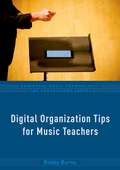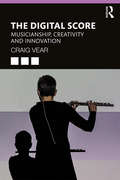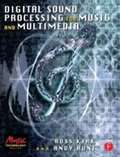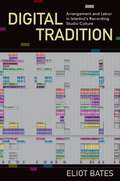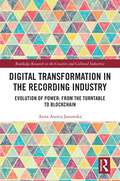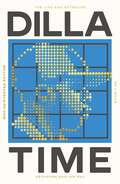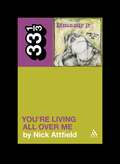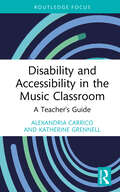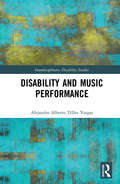- Table View
- List View
DIGITAL ORGANIZATION EMT C (Essential Music Technology: The Prestissimo Series)
by Robby BurnsAre you a music teacher searching for sanity in the midst of all your chaotic responsibilities? Music teachers have to do so much more than teach music. They have to be master musicians, educators, and conductors, all while balancing other professional disciplines like arranging, composing, trip planning, financing, and more. The parts of the job that take our sights off of great teaching must be managed so that we can focus on what counts: the music. If you are feeling overwhelmed by the logistics of your job, you are in luck- there is an app for that! Actually, a lot of apps. And Digital Organization Tips for Music Teachers is here to tell you all about them. Whether you can barely turn your computer on or if you are just looking for tips on how to make your work more efficient, there is something in store for you. The technologies in this book are presented in bite sized descriptions of desktop and mobile apps, followed by applications of how they can solve specific problems that music teachers experience every day. Each chapter covers a different type of data that music teachers have to organize, ranging from notes, to tasks, to scores and audio recordings.
Digital Organization Tips for Music Teachers (Essential Music Technology: The Prestissimo Series)
by Robby BurnsAre you a music teacher searching for sanity in the midst of all your chaotic responsibilities? Music teachers have to do so much more than teach music. They have to be master musicians, educators, and conductors, all while balancing other professional disciplines like arranging, composing, trip planning, financing, and more. The parts of the job that take our sights off of great teaching must be managed so that we can focus on what counts: the music. If you are feeling overwhelmed by the logistics of your job, you are in luck- there is an app for that! Actually, a lot of apps. And Digital Organization Tips for Music Teachers is here to tell you all about them. Whether you can barely turn your computer on or if you are just looking for tips on how to make your work more efficient, there is something in store for you. The technologies in this book are presented in bite sized descriptions of desktop and mobile apps, followed by applications of how they can solve specific problems that music teachers experience every day. Each chapter covers a different type of data that music teachers have to organize, ranging from notes, to tasks, to scores and audio recordings.
Digital Revolution Tamed: The Case of the Recording Industry
by Hyojung SunThis book explores why widespread predictions of the radical transformation in the recording industry did not materialise. Although the growing revenue generated from streaming signals the recovery of the digital music business, it is important to ask to what extent is the current development a response to digital innovation. Hyojung Sun finds the answer in the detailed innovation process that has taken place since Napster. She reassesses the way digital music technologies were encultured in complex music valorisation processes and demonstrates how the industry has become reintermediated rather than disintermediated. This book offers a new understanding of digital disruption in the recording industry. It captures the complexity of the innovation processes that brought about technological development, which arose as a result of interaction across the circuit of the recording business – production, distribution, valorisation, and consumption. By offering a more sophisticated account than the prevailing dichotomy, the book exposes deterministic myths surrounding the radical transformation of the industry.
Digital Scenography in Opera in the Twenty-First Century (Ashgate Interdisciplinary Studies in Opera)
by Caitlin VincentDigital Scenography in Opera in the Twenty-First Century is the first definitive study of the use of digital scenography in Western opera production. The book begins by exploring digital scenography’s dramaturgical possibilities and establishes a critical framework for identifying and comparing the use of digital scenography across different digitally enhanced opera productions. The book then investigates the impacts and potential disruptions of digital scenography on opera’s longstanding production conventions, both on and off the stage. Drawing on interviews with major industry practitioners, including Paul Barritt, Mark Grimmer, Donald Holder, Elaine J. McCarthy, Luke Halls, Wendall K. Harrington, Finn Ross, S. Katy Tucker, and Victoria ‘Vita’ Tzykun, author Caitlin Vincent identifies key correlations between the use of digital scenography in practice and subsequent impacts on creative hierarchies, production design processes, and organisational management. The book features detailed case studies of digitally enhanced productions premiered by Dutch National Opera, Komische Oper Berlin, Opéra de Lyon, The Royal Opera, Covent Garden, San Francisco Opera, Santa Fe Opera, Théâtre Royal de la Monnaie, The Metropolitan Opera, Victorian Opera, and Washington National Opera.
Digital Scenography in Opera in the Twenty-First Century (Ashgate Interdisciplinary Studies in Opera)
by Caitlin VincentDigital Scenography in Opera in the Twenty-First Century is the first definitive study of the use of digital scenography in Western opera production. The book begins by exploring digital scenography’s dramaturgical possibilities and establishes a critical framework for identifying and comparing the use of digital scenography across different digitally enhanced opera productions. The book then investigates the impacts and potential disruptions of digital scenography on opera’s longstanding production conventions, both on and off the stage. Drawing on interviews with major industry practitioners, including Paul Barritt, Mark Grimmer, Donald Holder, Elaine J. McCarthy, Luke Halls, Wendall K. Harrington, Finn Ross, S. Katy Tucker, and Victoria ‘Vita’ Tzykun, author Caitlin Vincent identifies key correlations between the use of digital scenography in practice and subsequent impacts on creative hierarchies, production design processes, and organisational management. The book features detailed case studies of digitally enhanced productions premiered by Dutch National Opera, Komische Oper Berlin, Opéra de Lyon, The Royal Opera, Covent Garden, San Francisco Opera, Santa Fe Opera, Théâtre Royal de la Monnaie, The Metropolitan Opera, Victorian Opera, and Washington National Opera.
The Digital Score: Musicianship, Creativity and Innovation
by Craig VearDigital technology is transforming the musical score as a broad array of innovative score systems have become available to musicians. From attempts to mimic the print score, to animated and graphical scores, to artificial intelligence-based options, digital scoring affects the musical process by opening up new possibilities for dynamic interaction between the performer and the music, changing how we understand the boundaries between composition, score, improvisation and performance. The Digital Score: Musicianship, Creativity and Innovation offers a guide into this new landscape, reflecting on what these changes mean for music-making from both theoretical and applied perspectives. Drawing on findings from over a decade’s worth of practice-based experimentation in the field, author Craig Vear builds a framework for understanding how digital scores create meaning. He considers the interactions between affect, embodiment and digital scores, offering the first comprehensive and critical consideration of an exciting field with no agreed-upon borders. Featuring insights from interviews with over fifty musicians and composers from across four continents, this book is a valuable resource for music researchers and practitioners alike.
The Digital Score: Musicianship, Creativity and Innovation
by Craig VearDigital technology is transforming the musical score as a broad array of innovative score systems have become available to musicians. From attempts to mimic the print score, to animated and graphical scores, to artificial intelligence-based options, digital scoring affects the musical process by opening up new possibilities for dynamic interaction between the performer and the music, changing how we understand the boundaries between composition, score, improvisation and performance. The Digital Score: Musicianship, Creativity and Innovation offers a guide into this new landscape, reflecting on what these changes mean for music-making from both theoretical and applied perspectives. Drawing on findings from over a decade’s worth of practice-based experimentation in the field, author Craig Vear builds a framework for understanding how digital scores create meaning. He considers the interactions between affect, embodiment and digital scores, offering the first comprehensive and critical consideration of an exciting field with no agreed-upon borders. Featuring insights from interviews with over fifty musicians and composers from across four continents, this book is a valuable resource for music researchers and practitioners alike.
Digital Sound Processing For Music And Multimedia
by Ross Kirk Andy HuntProvides an introduction to the nature, synthesis and transformation of sound which forms the basis of digital sound processing for music and multimedia. Background information in computer techniques is included so that you can write computer algorithms to realise new processes central to your own musical and sound processing ideas. Finally, material is inlcuded to explain the way in which people contribute to the development of new kinds of performance and composition systems. Key features of the book include: · Contents structured into free-standing parts for easy navigation · `Flow lines' to suggest alternative paths through the book, depending on the primary interest of the reader. · Practical examples are contained on a supporting website. Digital Sound Processing can be used by anyone, whether from an audio engineering, musical or music technology perspective. Digital sound processing in its various spheres - music technology, studio systems and multimedia - are witnessing the dawning of a new age. The opportunities for involvement in the expansion and development of sound transformation, musical performance and composition are unprecedented. The supporting website (www. york. ac. uk/inst/mustech/dspmm. htm) contains working examples of computer techniques, music synthesis and sound processing.
Digital Tradition: Arrangement and Labor in Istanbul's Recording Studio Culture
by Eliot BatesIstanbul is home to a multimillion dollar transnational music industry, which every year produces thousands of digital music recordings, including widely distributed film and television show soundtracks. Today, this centralized industry is responding to a growing global demand for Turkish, Kurdish, and other Anatolian ethnic language productions, and every year, many of its top-selling records incorporate elaborately orchestrated arrangements of rural folksongs. What accounts for the continuing demand for traditional music in local and diasporic markets? How is tradition produced in twenty-first century digital recording studios, and is there a "digital aesthetics" to contemporary recordings of traditional music? In Digital Traditions: Arrangement and Labor in Istanbul's Recording Studio Culture, author Eliot Bates answers these questions and more with a case study into the contemporary practices of recording traditional music in Istanbul. Bates provides an ethnography of Turkish recording studios, of arrangers and engineers, studio musicianship and digital audio workstation kinesthetics. Digital Traditions investigates the moments when tradition is arranged, and how arrangement is simultaneously a set of technological capabilities, limitations and choices: a form of musical practice that desocializes the ensemble and generates an extended network of social relations, resulting in aesthetic art objects that come to be associated with a range of affective and symbolic meanings. Rich with visual analysis and drawing on Science & Technology Studies theories and methods, Digital Traditions sets a new standard for the study of recorded music. Scholars and general readers of ethnomusicology, Middle Eastern studies, folklore and science and technology studies are sure to find Digital Traditions an essential addition to their library.
Digital Tradition: Arrangement and Labor in Istanbul's Recording Studio Culture
by Eliot BatesIstanbul is home to a multimillion dollar transnational music industry, which every year produces thousands of digital music recordings, including widely distributed film and television show soundtracks. Today, this centralized industry is responding to a growing global demand for Turkish, Kurdish, and other Anatolian ethnic language productions, and every year, many of its top-selling records incorporate elaborately orchestrated arrangements of rural folksongs. What accounts for the continuing demand for traditional music in local and diasporic markets? How is tradition produced in twenty-first century digital recording studios, and is there a "digital aesthetics" to contemporary recordings of traditional music? In Digital Traditions: Arrangement and Labor in Istanbul's Recording Studio Culture, author Eliot Bates answers these questions and more with a case study into the contemporary practices of recording traditional music in Istanbul. Bates provides an ethnography of Turkish recording studios, of arrangers and engineers, studio musicianship and digital audio workstation kinesthetics. Digital Traditions investigates the moments when tradition is arranged, and how arrangement is simultaneously a set of technological capabilities, limitations and choices: a form of musical practice that desocializes the ensemble and generates an extended network of social relations, resulting in aesthetic art objects that come to be associated with a range of affective and symbolic meanings. Rich with visual analysis and drawing on Science & Technology Studies theories and methods, Digital Traditions sets a new standard for the study of recorded music. Scholars and general readers of ethnomusicology, Middle Eastern studies, folklore and science and technology studies are sure to find Digital Traditions an essential addition to their library.
Digital Transformation in The Recording Industry: Evolution of Power: From The Turntable To Blockchain (Routledge Research in the Creative and Cultural Industries)
by Anna Anetta JanowskaThe recording industry has famously been transformed by technology throughout its entire history.The book presents an analysis of these changes using Porter's five forces model. The author highlights the evolution of buyers' and suppliers' power, the emergence of new competitors, product innovation and rivalry between companies in the industry driven by economic, political, social and legal factors.As an early mover in the social diffusion of copyright-sensitive content, the recording industry reflected in this book serves as an important reference for the analysis of other cultural and creative sectors.
Digital Transformation in The Recording Industry: Evolution of Power: From The Turntable To Blockchain (Routledge Research in the Creative and Cultural Industries)
by Anna Anetta JanowskaThe recording industry has famously been transformed by technology throughout its entire history.The book presents an analysis of these changes using Porter's five forces model. The author highlights the evolution of buyers' and suppliers' power, the emergence of new competitors, product innovation and rivalry between companies in the industry driven by economic, political, social and legal factors.As an early mover in the social diffusion of copyright-sensitive content, the recording industry reflected in this book serves as an important reference for the analysis of other cultural and creative sectors.
Dilla Time: The Life and Afterlife of J Dilla, the Hip-Hop Producer Who Reinvented Rhythm
by Dan Charnas'This book is a must for everyone interested in illuminating the idea of unexplainable genius' - QUESTLOVE Equal parts biography, musicology, and cultural history, Dilla Time chronicles the life and legacy of J Dilla, a musical genius who transformed the sound of popular music for the twenty-first century. He wasn’t known to mainstream audiences, and when he died at age thirty-two, he had never had a pop hit. Yet since his death, J Dilla has become a demigod, revered as one of the most important musical figures of the past hundred years. At the core of this adulation is innovation: as the producer behind some of the most influential rap and R&B acts of his day, Dilla created a new kind of musical time-feel, an accomplishment on a par with the revolutions wrought by Louis Armstrong and James Brown. Dilla and his drum machine reinvented the way musicians play. In Dilla Time, Dan Charnas chronicles the life of James DeWitt Yancey, from his gifted Detroit childhood to his rise as a sought-after hip-hop producer to the rare blood disease that caused his premature death. He follows the people who kept Dilla and his ideas alive. And he rewinds the histories of American rhythms: from the birth of Motown soul to funk, techno, and disco. Here, music is a story of what happens when human and machine times are synthesized into something new. This is the story of a complicated man and his machines; his family, friends, partners, and celebrity collaborators; and his undeniable legacy. Based on nearly two hundred original interviews, and filled with graphics that teach us to feel and "see" the rhythm of Dilla's beats, Dilla Time is a book as defining and unique as J Dilla's music itself. Financial Times Music Book of the Year 2022
Dimensions of Energy in Shostakovich's Symphonies
by Michael RofeShostakovich's music is often described as being dynamic, energetic. But what is meant by 'energy' in music? After setting out a broad conceptual framework for approaching this question, Michael Rofe proposes various potential sources of the perceived energy in Shostakovich's symphonies, describing also the historical significance of energeticist thought in Soviet Russia during the composer's formative years. The book is in two parts. In Part I, examples are drawn from across the symphonies in order to demonstrate energy streams within various musical dimensions. Three broad approaches are adopted: first, the theories of Boleslav Yavorsky are used to consider melodic-harmonic motion; second, Boris Asafiev's work, with its echoes of Ernst Kurth, is used to describe form as a dynamic process; and third, proportional analysis reveals numerous symmetries and golden sections within local and large-scale temporal structures. In Part II, the multi-dimensionality of musical energy is considered through case studies of individual movements from the symphonies. This in turn gives rise to broader contextualised perspectives on Shostakovich's work. The book ends with a detailed examination of why a piece of music might contain golden sections.
Dimensions of Energy in Shostakovich's Symphonies
by Michael RofeShostakovich's music is often described as being dynamic, energetic. But what is meant by 'energy' in music? After setting out a broad conceptual framework for approaching this question, Michael Rofe proposes various potential sources of the perceived energy in Shostakovich's symphonies, describing also the historical significance of energeticist thought in Soviet Russia during the composer's formative years. The book is in two parts. In Part I, examples are drawn from across the symphonies in order to demonstrate energy streams within various musical dimensions. Three broad approaches are adopted: first, the theories of Boleslav Yavorsky are used to consider melodic-harmonic motion; second, Boris Asafiev's work, with its echoes of Ernst Kurth, is used to describe form as a dynamic process; and third, proportional analysis reveals numerous symmetries and golden sections within local and large-scale temporal structures. In Part II, the multi-dimensionality of musical energy is considered through case studies of individual movements from the symphonies. This in turn gives rise to broader contextualised perspectives on Shostakovich's work. The book ends with a detailed examination of why a piece of music might contain golden sections.
Dinosaur Jr.'s You're Living All Over Me (33 1/3)
by Nick AttfieldDinosaur Jr, the stereotypical slackers. Mascis, Barlow, Murph (just Murph): three early-twentysomethings still overburdened by a torpid adolescence and a disastrous dress sense. With battered guitar, bass, and kit, they carry around a catalogue of songs that betrays identities half-formed at best, schizoid at worst. But listen. 1987, a new album, a snapshot of a moment when a furious musical intensity swung upwards and pushed their lyrics and Mascis's vocal whine far into the margins. Searing riffs, mountainous solos, and the tightest of fills – underpinned by stream-of-consciousness structures and a palette of crazed effects – steal the show. These three build a one-off sound that stirred up the hardening alternative mainstream and drove it to distraction. You're Living All Over Me: supposedly Mascis's indictment of what it was like to tour in a van with these other two misfits, but also testimony to the obsession – an itch, a disease – that the band's disengagement from their world had produced. This record cares so little it cares a lot.
Dinosaur Jr.'s You're Living All Over Me (33 1/3)
by Nick AttfieldDinosaur Jr, the stereotypical slackers. Mascis, Barlow, Murph (just Murph): three early-twentysomethings still overburdened by a torpid adolescence and a disastrous dress sense. With battered guitar, bass, and kit, they carry around a catalogue of songs that betrays identities half-formed at best, schizoid at worst. But listen. 1987, a new album, a snapshot of a moment when a furious musical intensity swung upwards and pushed their lyrics and Mascis's vocal whine far into the margins. Searing riffs, mountainous solos, and the tightest of fills – underpinned by stream-of-consciousness structures and a palette of crazed effects – steal the show. These three build a one-off sound that stirred up the hardening alternative mainstream and drove it to distraction. You're Living All Over Me: supposedly Mascis's indictment of what it was like to tour in a van with these other two misfits, but also testimony to the obsession – an itch, a disease – that the band's disengagement from their world had produced. This record cares so little it cares a lot.
Directors and the New Musical Drama: British and American Musical Theatre in the 1980s and 90s (Palgrave Studies in Theatre and Performance History)
by M. Lundskaer-NielsenThis is one of the first books to offer a rigorous analysis of the enormous changes in the musical theatre during the 1980s and 90s. In addition, it focuses on the contribution of well-known, serious theatre directors to the mainstream Musical Theatre and it is the first book to offer a dual Anglo-American perspective on this subject.
Dirigierende Maschinen: Musik mit technikgestützter Tempovermittlung (Musik und Klangkultur #62)
by Philippe KocherIn der musikalischen Aufführungspraxis ist es normalerweise der Mensch, der das Tempo erzeugt. Innerlich ein Tempo zu etablieren und es an das der mitmusizierenden Personen anzugleichen, ist eine grundlegende musikalische Fähigkeit. Was bedeutet es also, wenn das Tempo von einem technischen System vorgegeben wird? Philippe Kocher unterzieht diese besondere Art der Mensch-Maschine-Interaktion einer musikgeschichtlichen, technikgeschichtlichen und medienarchäologischen Betrachtung. Darüber hinaus entwickelt er innerhalb seiner wissenschaftlich-künstlerischen Studie ein eigenes System zur technikgestützten Tempovermittlung und beschreibt dessen Einsatz in der Praxis.
Dirigierende Maschinen: Musik mit technikgestützter Tempovermittlung (Musik und Klangkultur #62)
by Philippe KocherIn der musikalischen Aufführungspraxis ist es normalerweise der Mensch, der das Tempo erzeugt. Innerlich ein Tempo zu etablieren und es an das der mitmusizierenden Personen anzugleichen, ist eine grundlegende musikalische Fähigkeit. Was bedeutet es also, wenn das Tempo von einem technischen System vorgegeben wird? Philippe Kocher unterzieht diese besondere Art der Mensch-Maschine-Interaktion einer musikgeschichtlichen, technikgeschichtlichen und medienarchäologischen Betrachtung. Darüber hinaus entwickelt er innerhalb seiner wissenschaftlich-künstlerischen Studie ein eigenes System zur technikgestützten Tempovermittlung und beschreibt dessen Einsatz in der Praxis.
dis/cord: Thinking Sound through Agential Realism
by Kevin Toksöz Fairbarndis/cord is an experiment in reading sound. Embarking from Karen Barad’s early work on agential realism, it diffracts quantum physics through sound art, finding the sympathetic resonances that allow them to speak together. dis/cord believes in the materialism of sound, and strives not to understand it, but to become entangled with it. It asserts that impartial observation is impossible and understands immersion as a participatory and collaborative act. Sound art pieces provide the backdrop for a series of reflections on space, time, and matter. They trace the “marks on bodies” that sound leaves behind in its ephemeral vibration, finding new forms of sensation and interpretation through the pain and hearing loss that a life devoted to sound can cause. Drifting between sound studies, artistic research, musicology, and craftsmanship, dis/cord uses agential realism as a platform to approach thinking with, through, and about sound. Following Barad’s commitment to diffraction as a form of critique, it superposes a variety of sounds and ideas in the hope that their consonances and dissonances can provoke new ways of engaging with sound as a cultural and material agent. It is neither an appeal to scientist positivism nor a mystical immersion in listening. Rather, it builds from the intertwined physical and metaphysical curiosities that characterize Barad’s work, proposing a corporeal engagement with the disjointed temporal and spacial (dis)continuities that sonic materialism helps to build, understand, and create.
Disability and Accessibility in the Music Classroom: A Teacher's Guide (Modern Musicology and the College Classroom)
by Alexandria Carrico Katherine GrennellDisability and Accessibility in the Music Classroom provides college music history instructors with a concise guide on how to create an accessible and inclusive classroom environment. In addition to providing a concise overview of disability studies, highlighting definitions, theories, and national and international policies related to disability, this book offers practical applications for implementing accessibility measures in the music history classroom. The latter half of this text provides case studies of well-known disabled composers and musicians from the Western Art Music canon from the Middle Ages to the Twentieth Century as well as popular music genres, such as the blues, jazz, R&B, pop, country, and hip hop. These examples provide opportunities to integrate discussions of disability into a standard music history curriculum.
Disability and Accessibility in the Music Classroom: A Teacher's Guide (Modern Musicology and the College Classroom)
by Alexandria Carrico Katherine GrennellDisability and Accessibility in the Music Classroom provides college music history instructors with a concise guide on how to create an accessible and inclusive classroom environment. In addition to providing a concise overview of disability studies, highlighting definitions, theories, and national and international policies related to disability, this book offers practical applications for implementing accessibility measures in the music history classroom. The latter half of this text provides case studies of well-known disabled composers and musicians from the Western Art Music canon from the Middle Ages to the Twentieth Century as well as popular music genres, such as the blues, jazz, R&B, pop, country, and hip hop. These examples provide opportunities to integrate discussions of disability into a standard music history curriculum.
Disability and Music Performance (Interdisciplinary Disability Studies)
by Alejandro Alberto Téllez VargasDisability and Music Performance examines discriminatory social practices in music conservatoria, orchestras, music festivals and music competitions, which limit disabled people’s access to music performance at a professional level. Of particular interest are the disabling barriers that musicians with an intellectual, physical, sensory or neurological disability—or an acquired brain injury—encounter in the world of Western classical music, both as students and as professional performers. This book collects data in the form of semi-structured interviews and video and audio recordings to explore the voice, concerns and suggestions expressed by musicians with disabilities. It examines their perceptions of both inclusive and discriminatory practices in music institutions as well as the representation of, and audio-visual recordings by, key musical figures with disabilities. Its findings aim to contribute to the wellbeing of musicians with impairments by challenging disabling social practices that see them as inferior. This publication offers performers, teachers and researchers new perspectives for exploring some of the most common social dynamics in encounters between normative audiences, musicians and music critics, and musicians with disabilities. It invites the reader to recognise disability as a rightful identity category in music performance and to dismantle the disabling barriers that limit the participation of disabled people in music-making.
Disability and Music Performance (Interdisciplinary Disability Studies)
by Alejandro Alberto Téllez VargasDisability and Music Performance examines discriminatory social practices in music conservatoria, orchestras, music festivals and music competitions, which limit disabled people’s access to music performance at a professional level. Of particular interest are the disabling barriers that musicians with an intellectual, physical, sensory or neurological disability—or an acquired brain injury—encounter in the world of Western classical music, both as students and as professional performers. This book collects data in the form of semi-structured interviews and video and audio recordings to explore the voice, concerns and suggestions expressed by musicians with disabilities. It examines their perceptions of both inclusive and discriminatory practices in music institutions as well as the representation of, and audio-visual recordings by, key musical figures with disabilities. Its findings aim to contribute to the wellbeing of musicians with impairments by challenging disabling social practices that see them as inferior. This publication offers performers, teachers and researchers new perspectives for exploring some of the most common social dynamics in encounters between normative audiences, musicians and music critics, and musicians with disabilities. It invites the reader to recognise disability as a rightful identity category in music performance and to dismantle the disabling barriers that limit the participation of disabled people in music-making.
